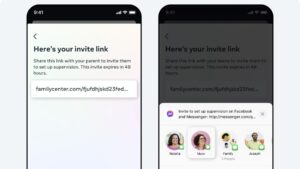Rich Johnston, a father of two school-aged children in Atlanta, thought AOL Instant Messenger was bad enough. Johnston recently told me that “away messages screwed with people’s brains,” stressed them out. The self-identified elder millennial also loves the fire hose of information that is X, formerly Twitter, and yes, he knows that’s weird.
“Now we’ve got Snapchat and TikTok and Instagram, and that’s got to be worse in 10 years,” he said. “That’s the terrifying part of bringing a kid up in this environment.”
He’s not the only one who feels this way. There’s now a nationwide and rather panicked push to keep smartphones out of kids’ hands and teens off of social media, pointing to a correlation between young people spending more time online and an increase in mental health problems. US Surgeon General Vivek Murthy even called for warning labels on social media platforms earlier this year.
This week that panic reached a tipping point.
Congress on Wednesday came one step closer to passing the Kids Online Safety and Privacy Act (KOSPA), as tech companies scramble to get ahead of what would be the most significant internet regulation in decades.
And just a day before that bill was set to be marked up in the House, Meta announced it was revamping Instagram with a new effort called Teen Accounts, which makes accounts of users under 18 private by default, restricts notifications at night, and gives parents options to supervise their kids. It’s not exactly taking Instagram away from teens, but it could dramatically change how they use it. This is the latest move by social media companies to make their platforms a bit less, well, terrifying for parents. YouTube and Snapchat made similar announcements this month.
Whether these developments will actually be good for kids remains an open question.
This is all happening against a backdrop where seven states have passed bans in schools, and another 14 are considering bans. There’s also a wave of cultural pressure, intensified by NYU professor Jonathan Haidt, whose latest book, The Anxious Generation, rallies parents to work together to “swim against the tide of ever-increasing screen time.” One of his collaborators, psychologist Jean Twenge, was one of the first to sound the alarm about the link between youth mental health and time online back in 2017 when she asked in an Atlantic essay, “Have smartphones destroyed a generation?”
To be clear, researchers like Haidt and Twenge aren’t suggesting we simply ban kids from ever touching a smartphone or scrolling through a social media feed. We don’t actually know how such bans or even changes in policy would affect youth mental health. Meanwhile, the school phone bans that have been sweeping the nation don’t govern what parents do at home. We are, however, starting to use the phrase “phone ban” a lot more than we used to.
“I hear that talk of a ban as a kind of howl of despair, really, that we’ve lost control,” said Sonia Livingstone, a professor of social psychology at the London School of Economics, who has been studying kids and tech for decades. “We’ve lost control of the feed from the companies, and we’ve lost control of our education and our health and our family life by accepting — as part of whatever kind of Faustian contract — the infrastructure of commerce.”
In other words, we’re letting the tech companies win.
Companies like Meta make money by getting their users to engage more with their products, so they can collect data about them and sell targeted ads accordingly. Instagram’s new Teen Accounts might make parents feel like they have a bit more control over how their kids factor into these transactions, but their kids’ attention is still the product.
KOSPA, however, targets the business models of social media platforms. The legislation, which combines the Kids Online Safety Act (KOSA) and the Children and Teen’s Online Privacy and Protection Act (COPPA 2.0), would ban targeted advertising to minors, allow users to turn off algorithmic sorting in their feeds, and bumps the minimum age requirement for online accounts from 13 to 17. It would also create a so-called “duty of care” for social media companies that would make them liable for harmful content on their platforms. The definition of what constitutes harmful content is still being hammered out in the bill’s language.
We don’t yet know the fate of KOSPA. Its predecessor, KOSA, passed the Senate in July with a vote of 93 in favor, 3 opposed. Tech companies and their lobbyists have been arguing against it, as have free speech advocates who believe it will open the door to censorship. Combined with whatever self-regulation social media platforms decide to do, such sweeping legislation could make it a little less terrifying to raise kids in our increasingly digital world. But it hardly guarantees an end to the youth mental health crisis.
Kids can learn healthy media habits — and you can too
The American Academy of Pediatrics (AAP) has an entire portal dedicated to kids and tech. A good starting point is the 5 Cs of Media Use — Child, Content, Calm, Crowding Out, and Communication — that help you evaluate the specific needs of your child. The AAP points out that although we’re accustomed to safety standards for childrens’ products, such regulations don’t currently exist for tech. “This means that kids are using platforms and apps that might have been designed for adults — not kids at their different stages of development,” according to the AAP.
Parents should also follow basic guidelines for healthy digital media use, like turning off notifications, avoiding screens before bed, limiting social media use, and just putting your phone away sometimes. You can live without looking at it for longer than you think.
To do that, Livingstone told me, we should study the causes of youth mental health problems, rather than focus on the consequences of screen time. Linda Charmaraman, founder and director of the Youth, Media, and Wellbeing Lab at Wellesley College, pointed to the surgeon general’s call for warnings on social media platforms as a sign of “a little bit of a hysterical panic.” She also said that solving the mental health problem will require more than a crackdown on smartphone use.
“People want something to stop that rise of mental illness as if this was going to be the magic bullet,” Charmaraman said. “I think it could actually cause people to not look at the other root causes of mental illness.”
It’s not just the kids, after all, who are having a hard time navigating life online. Surgeon General Murthy in August issued an advisory on the mental health and well-being of parents, and with it, the hand-wringing over kids and tech starts to resemble an ouroboros of anxiety. In a New York Times essay about the advisory, Murthy even points to “the impact of social media on youth mental health” as a source of mental health challenges for parents.
“Stress, loneliness and exhaustion can easily affect people’s mental health and well-being,” Murthy wrote. “And we know that the mental health of parents has a direct impact on the mental health of children.”
No wonder everyone’s feeling panicky. As Congress bands together to take aim at kids’ safety online and give parents more control over what their children see and do online, parents are stuck in a feedback loop. They’re stressed out by the child care crisis that Congress still won’t solve. They’re suffering through a loneliness epidemic with no end in sight. A 2022 Harvard study found that 20 percent of mothers and 15 percent of fathers reported anxiety, compared to 18 percent of teens. And almost 40 percent of teens said they were “somewhat worried” about their parents’ mental health.
We don’t yet know how changing the way social media works for kids will affect their mental health. There’s a chance that turning off algorithmic feeds will reduce the risk that they’re exposed to harmful content. It’s certainly possible that getting rid of targeted ads will have a positive effect. Better privacy is bound to keep kids safer from strangers online. If nothing else, we’ve at least started talking more about how these platforms work and could work better. And how we could feel better online and off.
“You can’t protect them from it forever,” Johnston, the dad from Atlanta, said. “So you’ve got to train them how to use it in a smart, safe, non-panic-inducing fashion as best you can.”
A version of this story was also published in the Vox Technology newsletter. Sign up here so you don’t miss the next one!



